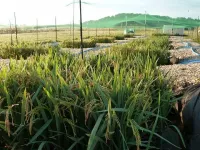'Zoombombing' research shows legitimate meeting attendees cause most attacks
2021-02-03
(Press-News.org) BINGHAMTON, NY -- Most zoombombing incidents are "inside jobs" according to a new study featuring researchers at Binghamton University, State University of New York.
As the COVID-19 virus spread worldwide in early 2020, much of our lives went virtual, including meetings, classes and social gatherings.
The videoconferencing app Zoom became an online home for many of these activities, but the migration also led to incidents of "zoombombing" -- disruptors joining online meetings to share racist or obscene content and cause chaos. Similar apps such as Google Meet and Skype also saw problems.
Cybersecurity experts expressed concerns about the apps' ability to thwart hackers. A new study from researchers at Binghamton University and Boston University, however, shows that most zoombombing incidents are "inside jobs."
Assistant Professor Jeremy Blackburn and PhD student Utkucan Balci from the Department of Computer Science at Binghamton's Thomas J. Watson College of Engineering and Applied Science teamed up with Boston University Assistant Professor Gianluca Stringhini and PhD student Chen Ling to analyze more than 200 calls from the first seven months of 2020.
They found that the vast majority of zoombombing are not caused by attackers stumbling upon meeting invitations or "bruteforcing" their ID numbers, but rather by insiders who have legitimate access to these meetings, particularly students in high school and college classes. Authorized users share links, passwords and other information on sites such as Twitter and 4chan, along with a call to stir up trouble.
"Some of the measures that people would think stops zoombombing -- such as requiring a password to enter a class or meeting -- did not deter anybody," Blackburn said. "Posters just post the password online as well.
"Even the waiting rooms in Zoom aren't a deterrent if zoombombers name themselves after people who are actually in the class to confuse the teacher. These strategies that circumvent the technical measures in place are interesting. It's not like they're hacking anything -- they're taking advantage of the weaknesses of people that we can't do anything about."
Because almost all targeting of Zoom meetings happens in real time (93% on 4chan and 98% on Twitter), the attacks seem to happen in an opportunistic fashion. Zoombombing posts cannot be identified ahead of time, so hosts have little or no time to prepare.
"It's unlikely that there can be a purely technical solution that isn't so tightly locked up that it becomes unusable," Blackburn said. "Passwords don't work -- that's the three-word summary of our research. We need to think harder about mitigation strategies."
Because of the worldwide reach of the internet, the research team found that the problem is not restricted to just one country or time zone.
"We found zoombombing calls from Turkey, Chile, Bulgaria, Italy and the United States," Balci said. "It's a globalized problem now because of the circumstances of COVID."
Examining the dark corners of the internet has been Blackburn's main research for the past decade, but as anonymity breeds antisocial behavior and hate, there are -- sadly -- always new topics to consider.
"When we start turning over rocks, it's amazing what crawls out from under them," he said. "We're trying to look for one problem, but we'll also find five other problems under there that are somehow related, and we have to look at that, too."
One big drawback to this kind of study is having to do both quantitative and qualitative analyses on vile hate speech. It even has to be published with a warning so that readers can brace themselves for what's ahead.
Blackburn and Balc both said that the camaraderie and open conversations at Blackburn's lab keeps everyone on an even keel.
"We do our best to make sure everybody is not taking it too personally," Blackburn said. "If you don't look at the content, you can't really do research about it, but if you look at the content too much or too deeply -- you stare into the abyss a bit too long -- you might fall into it. It's hard walking that line."
Balci added: "Sometimes I don't want to look at Twitter too much because the content is too overwhelming. It might depress me. However, from a research perspective, I'm curious about why these things happen. I just need to look at it in a more objective way."
The research, "A First Look at Zoombombing," was published by the IEEE Symposium on Security and Privacy (Oakland), 2021.
INFORMATION:
ELSE PRESS RELEASES FROM THIS DATE:
2021-02-03
Dogs have been faithful human companions ever since their domestication thousands of years ago. With various improvements in veterinary medicine in the past decades, their life expectancy has increased. However, an unfortunate side effect of this longevity, much like in humans, has been an increase in the occurrence of chronic and degenerative conditions.
In humans, modern efforts to fight such diseases have culminated in the development of regenerative therapies, largely based on stem cells. These "baby" cells have the potential to differentiate and mature into many specialized cell types-- called "pluripotency." By transplanting stem cells and guiding their differentiation into desired cell ...
2021-02-03
There are more than 350,000 angiosperms which are key components of ecosystems. It is now commonly accepted that their existence is essential for preserving a healthy environment and also for the production of food and raw materials. The growing world population and the challenges posed by climate change make the control of these natural resources one of the most crucial issues for all humanity in the future. In this regard, genome sequence information is of fundamental importance for understanding natural diversity and evolution of living organisms as well as for the design of breeding strategies aimed to produce new varieties with suitable traits.
Although the first genome sequence of the model plant Arabidopsis thaliana was produced more than twenty years ago, the sequencing ...
2021-02-03
When most people hear "food contamination," they think of bacteria present on unwashed fruits or vegetables, or undercooked meat. However, there are other ways for harmful contaminants to be present in food products.
Angelia Seyfferth, a member of the Soil Science Society of America, investigates food contamination coming from the soil where the plants grow. "It all comes down to the chemistry of the soil," explains Seyfferth.
Most recently, Seyfferth has been studying rice. The elements arsenic and cadmium can be present in the paddies where rice is grown. She presented her research at the virtual 2020 ASA-CSSA-SSSA Annual Meeting.
"Contaminants ...
2021-02-03
Study using surveys of more than 1.1 million 13-15-year-olds from 140 countries between 1999 and 2018, finds that the prevalence of smoking cigarettes on at least one day during the past 30 days decreased in 80 countries (57%) but was unchanged or increased in 60 countries (43%).
However, during the same time period, the prevalence of using other tobacco products, such as chewing tobacco, snuff, dip, cigars, cigarillos, pipe, or electronic cigarettes, levelled off or increased in 81 (59%) of 137 countries with available data.
Surveys of more than 530,000 adolescents from 143 countries between 2010 and 2018, finds that 17.9% of boys and 11.5% of girls used any tobacco product on at least one day during the past month.
Tokelau had the ...
2021-02-03
RIVERSIDE, Calif. -- A team led by a biomedical scientist at the University of California, Riverside, reports a drug -- an estrogen receptor ligand called indazole chloride (IndCl) -- has the potential to improve vision in patients with multiple sclerosis, or MS.
The study, performed on mice induced with a model of MS and the first to investigate IndCl's effect on the pathology and function of the complete afferent visual pathway, is published in Brain Pathology. The afferent visual pathway includes the eyes, optic nerve, and all brain structures responsible for receiving, transmitting, and processing visual information.
In MS, a disease ...
2021-02-02
Northwestern University researchers have developed a new approach to quantum device design that has produced the first gain-based long-wavelength infrared (LWIR) photodetector using band structure engineering based on a type-II superlattice material.
This new design, which demonstrated enhanced LWIR photodetection during testing, could lead to new levels of sensitivity for next-generation LWIR photodetectors and focal plane array imagers. The work could have applications in earth science and astronomy, remote sensing, night vision, optical communication, and thermal and medical imaging.
"Our design ...
2021-02-02
Oxford, February 2, 2021 - In an upcoming issue of the Journal of Medical Imaging and Radiation Sciences, published by Elsevier, undergraduate researchers from the University of Alberta's Radiation Therapy Program in the Faculty of Medicine and Dentistry describe how LGBTQ2SPIA+ patients face unique cancer risks, including fear of discrimination, higher incidence of certain cancer sites, and lower screening rates, resulting in more cancers detected at later stages.
"I understand that there are different gender pronouns, I do not understand them all."
To discover the knowledge, attitudes, and practice behaviors of the healthcare professionals treating these patients, the authors surveyed ...
2021-02-02
Beaten ballots: political participation dynamics amidst police interventions is the title of the academic article by Toni Rodon and Marc Guinjoan, lecturers of Political Sciences at UPF and the UB, respectively, which seeks to look in greater depth at the effects of police interventions regarding political participation, taking the "repression-mobilization" nexus debate as a starting point.
The study, published recently in the Cambridge University Press journal Political Science Research and Methods, focuses on the analysis of the referendum on independence held in Catalonia on 1 October 2017, when despite the police crackdown, 2,286,217 people voted, representing 44% of ...
2021-02-02
Experts predict that autonomous vehicles (AVs) will eventually make our roads safer since the majority of accidents are caused by human error. However, it may be some time before people are ready to put their trust in a self-driving car.
A new study in the journal Risk Analysis found that people are more likely to blame a vehicle's automation system and its manufacturer than its human driver when a crash occurs.
Semi-autonomous vehicles (semi-AVs), which allow humans to supervise the driving and take control of the vehicle, are already on the ...
2021-02-02
Recent global calamities - the pandemic, wildfires, floods - are spurring interdisciplinary scientists to nudge aside the fashionable First Law of Geography that dictates "everything is related to everything else, but near things are more related than distant things."
Geography, and by association, ecology, has largely followed what's known as Tobler's Law, which took hold in the early 1970s. But then came the novel coronavirus apparently has leapt from wildlife meat markets in China to the world in a matter of months. Global climate change creates conditions ripe for infernos in the North American west and Australia. ...
LAST 30 PRESS RELEASES:
[Press-News.org] 'Zoombombing' research shows legitimate meeting attendees cause most attacks



